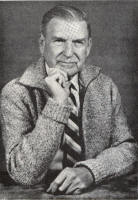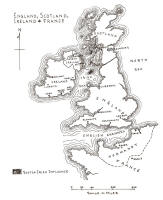|
 Most everyone at some time
or another has become curious about their
predecessors, but few do anything about it.
With the passage of time, the chances of
determining exact and detailed lineage become
more remote and the descendants become more
numerous and obscure through the interlacing
with other families with varying backgrounds. Most everyone at some time
or another has become curious about their
predecessors, but few do anything about it.
With the passage of time, the chances of
determining exact and detailed lineage become
more remote and the descendants become more
numerous and obscure through the interlacing
with other families with varying backgrounds.
The briefest scanning of
history indicates that no part of the inhabited
earth was ever free from countless invasions,
settlements, counter invasions and dominations
to the point where it is difficult to conceive
of any pure strain of humanity existing and that
the so called "melting pot" has been boiling
since the creation of man.
There is no doubt that the
Emerald Isle has been inhabited since the last
glaciers left those shores and man's ability to
chronicle the life and times of
 those peoples
has been reduced to just a fragment of time in
its overall history. Since the Milesians were
the least likely to have gotten their names from
the residents of Ireland who were being invaded,
they were designated as the true ancestors of
the Irish, though the people who already
occupied Ireland must have had some standing in
the matter. In ancient times, Ireland, as well
as Scotland and England, assumed a language that
came to be identified as Gaelic, Celtic, and
Erse. those peoples
has been reduced to just a fragment of time in
its overall history. Since the Milesians were
the least likely to have gotten their names from
the residents of Ireland who were being invaded,
they were designated as the true ancestors of
the Irish, though the people who already
occupied Ireland must have had some standing in
the matter. In ancient times, Ireland, as well
as Scotland and England, assumed a language that
came to be identified as Gaelic, Celtic, and
Erse.
While Ireland always seems
to be included on the agenda of the numerous
invaders, England was the prime target and the
"invasions" of Ireland consisted of no more than
periodic "raids" by the closer associated
factions
 such as the Norsemen, Normans, etc.
Even the Romans did not extend their supply
lines to engulf Ireland or North Scotland. Wars
seemed to have been inspired more over concern
for real estate than high flown principles. The
main purpose of the invasions was not so much
towards colonization as it was to gain wealth
for the home front. Even with the Romans, the
prime purpose of occupying the south of England
was to gain access to the tin deposits of Wales
to improve their weapons and tools. Even
Patrick, who became the patron saint of Ireland,
was in no way Irish and had been, in fact, born
of Roman parentage during the latter years of
the Roman occupation in south England. such as the Norsemen, Normans, etc.
Even the Romans did not extend their supply
lines to engulf Ireland or North Scotland. Wars
seemed to have been inspired more over concern
for real estate than high flown principles. The
main purpose of the invasions was not so much
towards colonization as it was to gain wealth
for the home front. Even with the Romans, the
prime purpose of occupying the south of England
was to gain access to the tin deposits of Wales
to improve their weapons and tools. Even
Patrick, who became the patron saint of Ireland,
was in no way Irish and had been, in fact, born
of Roman parentage during the latter years of
the Roman occupation in south England.
 It was the Vikings who
built the first cities in Ireland, including
Dublin, Cork and others and it was the Vikings
who divided Ireland into counties, townships
and districts to become the first attempt at
organized government. All of this had a definite
influence on the character and bloodlines of the
inhabitants of Ireland. The true Irish were mere
savages from way back and conducted themselves,
as such, into modern times. It was the Vikings who
built the first cities in Ireland, including
Dublin, Cork and others and it was the Vikings
who divided Ireland into counties, townships
and districts to become the first attempt at
organized government. All of this had a definite
influence on the character and bloodlines of the
inhabitants of Ireland. The true Irish were mere
savages from way back and conducted themselves,
as such, into modern times.
History is written up
through numerous and varied interpretations
taken from available facts and evidence. It has
been altered and embellished to suit the
political scene of the time and has been
saturated with imagination to pad it out to such
an extent as to be unable to distinguish fact
from fiction but which, for the lack of any more
precise record, we are taught to accept as
gospel. The account, herein, will not be much
different. The names, places and dates are all
authentic to the best of our knowledge, while
the narrative will be taken from scraps of
information recounting what was known of the
everyday lives of those included. It will be
filled in based on written accounts by others as
to events and modes of life typical to the
related periods.
 During the search for
information it was surprising the number of
people who professed to be writing up histories
of their immediate families of the same name. No
attempt is made to infringe on those who feel
they have patent rights to their efforts in
research and the results obtained nor is there
or will there be any claim to the patent on the
material and information disclosed in this
account. The basic information and everything
discussed herein, as vital statistics and
historical events, are a matter of public
record. During the search for
information it was surprising the number of
people who professed to be writing up histories
of their immediate families of the same name. No
attempt is made to infringe on those who feel
they have patent rights to their efforts in
research and the results obtained nor is there
or will there be any claim to the patent on the
material and information disclosed in this
account. The basic information and everything
discussed herein, as vital statistics and
historical events, are a matter of public
record.
No one can claim any patent
rights on the public record of any individual,
and as to the circumstances of their private
lives, this is purely the writer's style and
concept which would be very coincidental if not
impossible to duplicate without consultation.
It is only in recent years
that exact dates, names and places of residence
have been required of us in our daily
confrontation with Social Security, retirement,
voting privileges, job procurement and a host of
other matters.
 Our ancestors, who preceded us
prior to the advent of such necessities, were
somewhat lax in producing such basic evidence
in precise form and therefore there have been
omissions in documents which leave minor
conflicts in trying to pin them down. In many
instances the scribes and recorders had to rely
on phonetics since there was much illiteracy.
Nevertheless, these are all real people and
dates and places have been confirmed to the
extent that, for the most part, all were
legitimate and not existing in more than one
place at the same time. Our ancestors, who preceded us
prior to the advent of such necessities, were
somewhat lax in producing such basic evidence
in precise form and therefore there have been
omissions in documents which leave minor
conflicts in trying to pin them down. In many
instances the scribes and recorders had to rely
on phonetics since there was much illiteracy.
Nevertheless, these are all real people and
dates and places have been confirmed to the
extent that, for the most part, all were
legitimate and not existing in more than one
place at the same time.
|